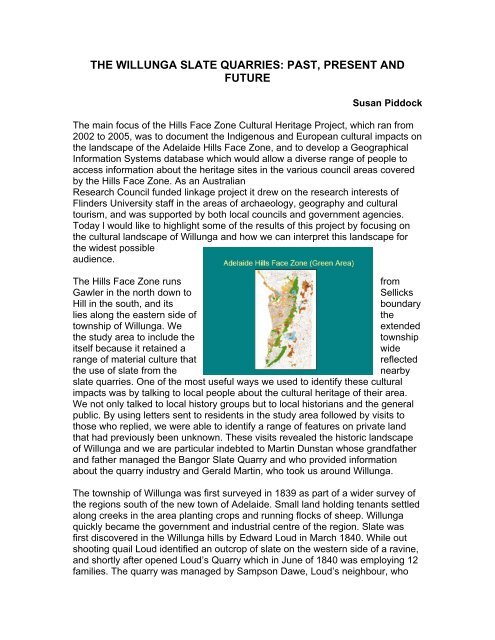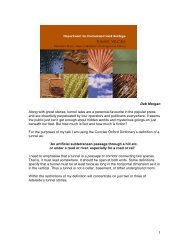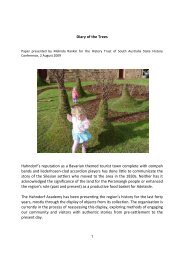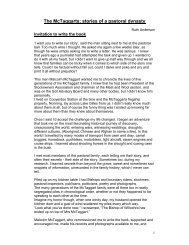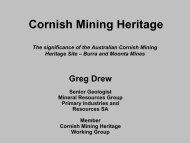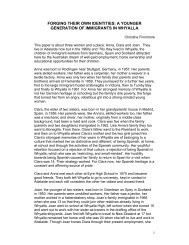the willunga slate quarries: past, present and future - History SA
the willunga slate quarries: past, present and future - History SA
the willunga slate quarries: past, present and future - History SA
Create successful ePaper yourself
Turn your PDF publications into a flip-book with our unique Google optimized e-Paper software.
THE WILLUNGA SLATE QUARRIES: PAST, PRESENT AND<br />
FUTURE<br />
Susan Piddock<br />
The main focus of <strong>the</strong> Hills Face Zone Cultural Heritage Project, which ran from<br />
2002 to 2005, was to document <strong>the</strong> Indigenous <strong>and</strong> European cultural impacts on<br />
<strong>the</strong> l<strong>and</strong>scape of <strong>the</strong> Adelaide Hills Face Zone, <strong>and</strong> to develop a Geographical<br />
Information Systems database which would allow a diverse range of people to<br />
access information about <strong>the</strong> heritage sites in <strong>the</strong> various council areas covered<br />
by <strong>the</strong> Hills Face Zone. As an Australian<br />
Research Council funded linkage project it drew on <strong>the</strong> research interests of<br />
Flinders University staff in <strong>the</strong> areas of archaeology, geography <strong>and</strong> cultural<br />
tourism, <strong>and</strong> was supported by both local councils <strong>and</strong> government agencies.<br />
Today l would like to highlight some of <strong>the</strong> results of this project by focusing on<br />
<strong>the</strong> cultural l<strong>and</strong>scape of Willunga <strong>and</strong> how we can interpret this l<strong>and</strong>scape for<br />
<strong>the</strong> widest possible<br />
audience.<br />
The Hills Face Zone runs from<br />
Gawler in <strong>the</strong> north down to Sellicks<br />
Hill in <strong>the</strong> south, <strong>and</strong> its boundary<br />
lies along <strong>the</strong> eastern side of <strong>the</strong><br />
township of Willunga. We extended<br />
<strong>the</strong> study area to include <strong>the</strong> township<br />
itself because it retained a wide<br />
range of material culture that reflected<br />
<strong>the</strong> use of <strong>slate</strong> from <strong>the</strong> nearby<br />
<strong>slate</strong> <strong>quarries</strong>. One of <strong>the</strong> most useful ways we used to identify <strong>the</strong>se cultural<br />
impacts was by talking to local people about <strong>the</strong> cultural heritage of <strong>the</strong>ir area.<br />
We not only talked to local history groups but to local historians <strong>and</strong> <strong>the</strong> general<br />
public. By using letters sent to residents in <strong>the</strong> study area followed by visits to<br />
those who replied, we were able to identify a range of features on private l<strong>and</strong><br />
that had previously been unknown. These visits revealed <strong>the</strong> historic l<strong>and</strong>scape<br />
of Willunga <strong>and</strong> we are particular indebted to Martin Dunstan whose gr<strong>and</strong>fa<strong>the</strong>r<br />
<strong>and</strong> fa<strong>the</strong>r managed <strong>the</strong> Bangor Slate Quarry <strong>and</strong> who provided information<br />
about <strong>the</strong> quarry industry <strong>and</strong> Gerald Martin, who took us around Willunga.<br />
The township of Willunga was first surveyed in 1839 as part of a wider survey of<br />
<strong>the</strong> regions south of <strong>the</strong> new town of Adelaide. Small l<strong>and</strong> holding tenants settled<br />
along creeks in <strong>the</strong> area planting crops <strong>and</strong> running flocks of sheep. Willunga<br />
quickly became <strong>the</strong> government <strong>and</strong> industrial centre of <strong>the</strong> region. Slate was<br />
first discovered in <strong>the</strong> Willunga hills by Edward Loud in March 1840. While out<br />
shooting quail Loud identified an outcrop of <strong>slate</strong> on <strong>the</strong> western side of a ravine,<br />
<strong>and</strong> shortly after opened Loud’s Quarry which in June of 1840 was employing 12<br />
families. The quarry was managed by Sampson Dawe, Loud’s neighbour, who
was familiar with <strong>slate</strong> quarrying in Cornwall. Within three months Sampson<br />
Dawe went on to find <strong>slate</strong> on his property 1.6 kilometres north-east of Loud’s<br />
Quarry <strong>and</strong> <strong>the</strong> Delabole Quarry was established, deriving its name from <strong>the</strong><br />
Delabole Slate Quarry in Cornwall. This <strong>slate</strong> was from a reef which was 4 miles<br />
long <strong>and</strong> 3,000 feet deep. On this slide<br />
Loud’s quarry is on <strong>the</strong> lower left <strong>and</strong><br />
above it is Delabole. Loud’s Quarry<br />
closed soon after <strong>the</strong> opening of <strong>the</strong><br />
Delabole Quarry as its <strong>slate</strong> was<br />
superior to Loud’s making it a more<br />
viable venture. By 1841 over 150,000<br />
roofing <strong>slate</strong>s had been shipped from<br />
<strong>the</strong> Willunga <strong>quarries</strong>. They were taken<br />
by bullock drays to <strong>the</strong> coast at Aldinga<br />
Bay <strong>and</strong> shipped to Port Adelaide,<br />
Melbourne <strong>and</strong> Sydney.<br />
The <strong>slate</strong> trade continued to grow with <strong>the</strong> opening up of <strong>the</strong> Willunga Slate<br />
Quarry by Thomas Williams in 1842. Ano<strong>the</strong>r quarry was opened by James<br />
Gregory & Co. in September 1842 but <strong>the</strong> competition provided by English <strong>slate</strong><br />
<strong>and</strong> <strong>the</strong> o<strong>the</strong>r <strong>quarries</strong> saw <strong>the</strong> company unable to pay its rent to <strong>the</strong> South<br />
Australian Government <strong>and</strong> <strong>the</strong> lease was given up 19 months after it was taken<br />
up. In 1846 Sampson Dawe <strong>and</strong> Thomas Polkinghorne, a former member of<br />
James Gregory & Co., took up this lease <strong>and</strong> <strong>the</strong> quarry on Section 1008<br />
became Martin’s Quarry. A second quarry was opened up near by Martin’s by<br />
Sampson Bastian. The Bastian’s <strong>and</strong> Martin’s <strong>quarries</strong> were located near <strong>the</strong><br />
Glenunga Creek in <strong>the</strong> Beltana Gully.
In 1861 Sampson Dawe sold <strong>the</strong><br />
Delabole Quarry to J. Allen who in turn<br />
sold it to <strong>the</strong> Australian Delabole Slate<br />
Co. on August 30 th 1865. While <strong>the</strong><br />
transfer documents appear to indicate<br />
that <strong>the</strong>re may have been buildings on<br />
<strong>the</strong> l<strong>and</strong>, this may have been a st<strong>and</strong>ard<br />
legal phrase, as <strong>the</strong> Delabole cottages<br />
which are still visible on <strong>the</strong> l<strong>and</strong>scape<br />
today appear to have been built by <strong>the</strong><br />
Australian Delabole Slate Company.<br />
Their construction is detailed in <strong>the</strong> newspaper accounts of <strong>the</strong> company’s first<br />
half yearly meeting which indicated that <strong>the</strong> six worker’s cottages close to <strong>the</strong><br />
quarry faces was nearly complete <strong>and</strong> that <strong>the</strong> construction of <strong>the</strong> foreman’s<br />
office <strong>and</strong> residence on <strong>the</strong> road down to <strong>the</strong> quarry faces was underway. In<br />
1866 <strong>the</strong> workers at <strong>the</strong> <strong>slate</strong> quarry erected a Wesleyan Chapel on <strong>the</strong> hill<br />
opposite <strong>the</strong> cottages <strong>and</strong> adjoining <strong>the</strong> roadway down to <strong>the</strong> quarry. Services<br />
were held in <strong>the</strong> Chapel <strong>and</strong> a Sunday School was provided for <strong>the</strong> children of<br />
Delabole.<br />
While <strong>the</strong> Delabole Quarry was <strong>the</strong> main supplier of roofing <strong>slate</strong> in Australia<br />
from 1840 to 1893, <strong>the</strong> growing popularity of galvanised <strong>and</strong> o<strong>the</strong>r roofing<br />
materials in <strong>the</strong> later 19 th century saw interest in <strong>slate</strong> fall. The Delabole Quarry<br />
suffered a slow decline in its workings until Allen who had repurchased <strong>the</strong> l<strong>and</strong><br />
in 1872 sold <strong>the</strong> l<strong>and</strong> to G. Ware purely for grazing in 1903.<br />
Along with Martin <strong>and</strong> Bastian’s <strong>and</strong> Delabole, <strong>the</strong> Bangor Quarry was <strong>the</strong> o<strong>the</strong>r<br />
major <strong>slate</strong> quarry at Willunga <strong>and</strong> continues to operate today as a commercial<br />
quarry as does Martin’s. Bangor was initially opened in 1842 by Thomas<br />
Williams, it is not clear whe<strong>the</strong>r he owned <strong>the</strong> l<strong>and</strong> or leased it. Certainly in 1856<br />
<strong>the</strong> quarry was being leased by Kernick, Male <strong>and</strong> Cobbledick. Experienced<br />
Cornish stone dressers, <strong>the</strong>y had been working a quarry owned by <strong>the</strong> Martin<br />
family, but with its collapse, <strong>the</strong>y entered a rental contract on <strong>the</strong> Bangor Quarry<br />
for £125, with <strong>the</strong> option of purchasing it for £1,000. After <strong>the</strong> first 21 year lease<br />
expired, <strong>the</strong>y took out a fur<strong>the</strong>r 7 year lease. After this <strong>the</strong> quarry passed through<br />
several owners before being ab<strong>and</strong>oned.<br />
In 1917 John Dunstan, a Sydney architect, <strong>and</strong> William Noller, a builder <strong>and</strong><br />
contractor, tendered for <strong>the</strong> quarry <strong>and</strong> The Australian Slate Co. was formed to<br />
operate <strong>the</strong> quarry. By 1919 <strong>the</strong> quarry was producing between 500,000 <strong>and</strong><br />
2,000,000 <strong>slate</strong>s per year as required. The First World War was to affect <strong>the</strong><br />
availability of galvanised iron, <strong>and</strong> <strong>slate</strong> was <strong>the</strong> ideal replacement, however from<br />
<strong>the</strong> late 1920s <strong>the</strong> availability of terracotta tiles for roofing saw a renewed<br />
decline. By <strong>the</strong> 1940s <strong>the</strong> quarry was only producing walling <strong>and</strong> paving flags.
Slate was quarried directly from <strong>the</strong> hill face where <strong>the</strong> seam of <strong>slate</strong> was<br />
identified. At Martin’s <strong>and</strong> Delabole several quarry faces were opened to access<br />
<strong>the</strong> <strong>slate</strong>, at Bangor <strong>the</strong> quarry face was over a hundred feet in height. Slate was<br />
obtained from <strong>the</strong> quarry faces by blasting <strong>and</strong> was <strong>the</strong>n cut into workable<br />
pieces. As <strong>the</strong> <strong>slate</strong> was worked down from <strong>the</strong> top, it was possible to create<br />
plateaus on which <strong>the</strong> quarrymen would climb.<br />
After climbing on top of <strong>the</strong> <strong>slate</strong> mass<br />
which had been moved, a worker inserted<br />
a wedge between <strong>the</strong> layers <strong>and</strong> split <strong>the</strong><br />
<strong>slate</strong>. A high level of skill was required to<br />
produce <strong>the</strong> largest block. The South<br />
Australian Register in 1868 reported that<br />
at Delabole, <strong>the</strong>se were up to several<br />
inches thick <strong>and</strong> 90 superficial feet in<br />
extent. The hill men would <strong>the</strong>n split <strong>the</strong><br />
<strong>slate</strong> block into <strong>the</strong> proper size <strong>and</strong><br />
thickness required by <strong>the</strong> <strong>slate</strong> dressers. The art was to determine <strong>the</strong> proper<br />
number of <strong>slate</strong>s a block would produce. An incorrect decision would lead to<br />
pieces of <strong>slate</strong> that were too thick or too thin, liable to breaking or of inferior<br />
quality. The blocks would <strong>the</strong>n be loaded by winch into trucks <strong>and</strong> sent to <strong>the</strong><br />
working site via a tramline. Here <strong>the</strong> dresser would cut <strong>the</strong> <strong>slate</strong> to a series of<br />
sizes ei<strong>the</strong>r manually or using a machine. Manually <strong>the</strong> <strong>slate</strong>s were cut using a<br />
notched gauge <strong>and</strong> an iron frame to<br />
mark out <strong>the</strong> sizes of <strong>slate</strong>s to be cut<br />
from a block. A block <strong>and</strong> <strong>the</strong> tools used<br />
at <strong>the</strong> <strong>quarries</strong> can be seen today at <strong>the</strong><br />
Willunga Slate Museum.
We know from historic<br />
documentation that most of <strong>the</strong><br />
Willunga <strong>slate</strong> <strong>quarries</strong> had a<br />
range of infrastructures that<br />
supported <strong>the</strong> quarrying process,<br />
including workshops, cranes, <strong>and</strong><br />
tram lines, however today much of <strong>the</strong><br />
evidence of <strong>the</strong>se structures<br />
has disappeared as equipment<br />
could be sold <strong>and</strong> reused. However<br />
<strong>the</strong>re are some features remaining<br />
at <strong>the</strong> <strong>quarries</strong> that reflect <strong>the</strong> <strong>past</strong><br />
quarrying activities. At Delabole it is possible to see where <strong>the</strong> <strong>slate</strong> was quarried<br />
<strong>and</strong> where <strong>the</strong> water course was altered to flow through drains <strong>and</strong> to supply a<br />
well on <strong>the</strong> plateau where <strong>the</strong>y cut <strong>the</strong> <strong>slate</strong>. Above <strong>the</strong> three quarry faces a<br />
complex of ponds <strong>and</strong> drains controlling water flow was constructed of <strong>slate</strong> <strong>and</strong><br />
<strong>the</strong> hillside benching is still visible where <strong>the</strong> tramline probably ran. At Bangor it is<br />
possible to see <strong>the</strong> remains of <strong>the</strong> Slate<br />
Mill, a <strong>slate</strong> lined well next to <strong>the</strong> quarry<br />
face, <strong>the</strong> quarry office, <strong>and</strong> powder<br />
magazine as well as <strong>the</strong> quarry face,<br />
which has been partially filled in. But it is<br />
not just <strong>the</strong> <strong>quarries</strong> that have survived, at<br />
Delabole it is possible to see <strong>the</strong> remains<br />
of <strong>the</strong> Delabole cottages built on to <strong>the</strong><br />
hillsides a stone’s throw away from <strong>the</strong><br />
quarry itself, as well as <strong>the</strong> foreman’s<br />
house <strong>and</strong> office, <strong>and</strong> <strong>the</strong> chapel.<br />
Adjacent to <strong>the</strong> cottages are <strong>slate</strong><br />
retaining walls that probably defined<br />
<strong>the</strong> cottage gardens.<br />
However <strong>the</strong> heritage of <strong>the</strong> <strong>slate</strong><br />
<strong>quarries</strong> is not limited to <strong>the</strong>se<br />
places. Slate was used for a variety<br />
of purposes, many one examples of<br />
which can be seen if one looks<br />
around <strong>the</strong> township of Willunga <strong>and</strong><br />
<strong>the</strong> surrounding countryside. Slate<br />
water tanks can be found throughout <strong>the</strong> area, <strong>and</strong> fencing posts, drains<br />
alongside <strong>the</strong> roads <strong>and</strong> sheep pens were made from sheets <strong>and</strong> pieces of <strong>slate</strong>.<br />
The Martin family sheep run was constructed of <strong>slate</strong> as were many roofs in <strong>the</strong><br />
area. Glantawe built by Martin Dunstan’s gr<strong>and</strong>fa<strong>the</strong>r was entirely constructed of<br />
<strong>slate</strong> using timber frames as were <strong>the</strong> garage <strong>and</strong> fence. Slate was also used to<br />
build walls in a manner similar to that used for dry stone walls for cottages <strong>and</strong><br />
o<strong>the</strong>r buildings, <strong>and</strong> examples of this can still be seen around Willunga.
Gravestones were also made of <strong>slate</strong> <strong>and</strong> <strong>the</strong>se can be seen in <strong>the</strong> church<br />
cemeteries. The Hills Face Project was <strong>the</strong>n able to identify <strong>and</strong> record not just<br />
<strong>the</strong> heritage of <strong>the</strong> <strong>slate</strong> <strong>quarries</strong> but identified a wider l<strong>and</strong>scape that reflects<br />
both <strong>the</strong> importance of <strong>slate</strong> to <strong>the</strong> community <strong>and</strong> <strong>the</strong> uses <strong>slate</strong> was put to that<br />
link into <strong>the</strong> agricultural <strong>and</strong> <strong>past</strong>oral industries of <strong>the</strong> area.<br />
The preservation of <strong>past</strong> l<strong>and</strong>scapes such as that identified at Willunga very<br />
much rests in <strong>the</strong> h<strong>and</strong>s of local communities <strong>and</strong> in <strong>the</strong> h<strong>and</strong>s of developers.<br />
The essential key to maintaining <strong>the</strong>se links with <strong>the</strong> <strong>past</strong> is knowledge. It is <strong>the</strong><br />
older members of <strong>the</strong> community who are <strong>the</strong> ones with a fund of local<br />
knowledge which may or may not be recorded in some way, <strong>and</strong> it is often <strong>the</strong>se<br />
people who lead <strong>the</strong> fight to preserve local heritage. As has been demonstrated<br />
in <strong>the</strong> <strong>past</strong> heritage listing in any form is not a protection against <strong>the</strong> destruction<br />
of a place <strong>and</strong> often <strong>the</strong> heritage or importance of a building is not realised until<br />
it’s too late to protect it. Last minute battles between developers <strong>and</strong> local<br />
communities are often recorded in local papers with only well known sites making<br />
it into <strong>the</strong> Advertiser. The village of Delabole is listed on <strong>the</strong> South Australian<br />
Register of State Heritage Items but has significantly suffered over <strong>the</strong> last 40<br />
years <strong>and</strong> <strong>the</strong> buildings are rapidly disappearing.<br />
As can be seen by this first slide taken in<br />
<strong>the</strong> mid 1960s <strong>the</strong> walls of <strong>the</strong> Delabole buildings were largely intact with<br />
windows still in place. In 1972 <strong>the</strong><br />
deterioration had begun. In 1996 this process had become marked with parts of<br />
<strong>the</strong> walls collapsing, but <strong>the</strong> lines of <strong>the</strong> original walls were still evident allowing<br />
Pauline O’Malley to draw <strong>the</strong> cottages as part of an archaeological study.
In 2004 <strong>the</strong> buildings were showing signs of being significantly damaged, most of<br />
<strong>the</strong> windows have disappeared. This deterioration is most evident at <strong>the</strong><br />
Foreman’s cottage as demonstrated by this slide. In 1996 it was possible to<br />
determine <strong>the</strong> original room shapes <strong>and</strong> sizes, in 2004 <strong>the</strong>re were only a few<br />
pieces of <strong>the</strong> walls still st<strong>and</strong>ing. This cottage near <strong>the</strong> creek had largely<br />
disappeared by 2004. This more than anything demonstrates <strong>the</strong> fragility of <strong>the</strong><br />
<strong>past</strong>. Delabole like many of <strong>the</strong> sites where <strong>slate</strong> has been used for a variety of<br />
purposes discussed in this paper are on private l<strong>and</strong> <strong>and</strong> as such <strong>the</strong>y can not be<br />
readily accessed by <strong>the</strong> general public which in turn would generate interest in<br />
<strong>the</strong>ir preservation, consequentially we have to find ano<strong>the</strong>r way of bringing <strong>the</strong><br />
cultural heritage <strong>and</strong> history of Willunga to a wider audience.<br />
We need to find ways to interest <strong>the</strong> wider community not just children who are<br />
most often <strong>the</strong> ones targeted for structured activities. We need to involve <strong>the</strong>ir<br />
parents <strong>and</strong> visitors to an area. A significant step towards this has been<br />
undertaken by <strong>the</strong> Willunga Branch of <strong>the</strong> National Trust with <strong>the</strong> opening of <strong>the</strong><br />
<strong>slate</strong> Museum in <strong>the</strong> Police Stables near <strong>the</strong> Courthouse Museum. This museum<br />
seeks to explore <strong>the</strong> working of <strong>the</strong> <strong>slate</strong> <strong>quarries</strong> <strong>and</strong> to people <strong>the</strong> <strong>past</strong> through<br />
artefacts <strong>and</strong> stories. In <strong>the</strong> <strong>past</strong> tours have been held <strong>and</strong> <strong>the</strong>se are a good way<br />
of allowing people to visit <strong>the</strong>se places.<br />
Such tours can be supported by brochures<br />
that highlight <strong>the</strong> story of <strong>the</strong> <strong>quarries</strong>. A<br />
fur<strong>the</strong>r option is to place interpretative<br />
signage nearby <strong>the</strong> sites on adjacent roads<br />
so that people can physically locate <strong>the</strong><br />
places in <strong>the</strong> l<strong>and</strong>scape without actually<br />
going on to properties, for example at <strong>the</strong><br />
<strong>quarries</strong> <strong>and</strong> Delabole. These signs would<br />
need to include photographs <strong>and</strong><br />
illustrations if <strong>the</strong>y are to have any value if<br />
<strong>the</strong> sites are not accessible. This has been<br />
done in Fremantle, Western Australia in an unobtrusive way.<br />
The most effective way to interpret <strong>the</strong> Willunga l<strong>and</strong>scapes <strong>and</strong> its stories may<br />
be through <strong>the</strong> World Wide Web. The use of interactive tours within a website<br />
that includes photographs of sites on private property without providing location
details would allow people to explore <strong>the</strong> Willunga l<strong>and</strong>scape without <strong>the</strong> inherent<br />
dangers of people walking through <strong>the</strong> l<strong>and</strong>scapes. As l indicated before <strong>the</strong><br />
Delabole l<strong>and</strong>scape is very fragile <strong>and</strong> <strong>the</strong> safety issues of people walking across<br />
very steep hillsides brings its own inherent problems. Within a website it would<br />
be possible to use oral histories, ei<strong>the</strong>r as voice recordings or as story links to<br />
record memories before <strong>the</strong>y disappear with <strong>the</strong> passing of those who worked in<br />
<strong>the</strong> <strong>slate</strong> <strong>quarries</strong>. Video footage could also be linked in allowing <strong>the</strong> techniques<br />
of <strong>slate</strong> dressing to be recorded, for while historical documents are useful, <strong>the</strong><br />
subtilises of actually watching someone work can make a vast difference to our<br />
underst<strong>and</strong>ing of <strong>the</strong> processes involved. In an age of mechanisation <strong>and</strong><br />
computers traditional skills are rapidly being lost. These traditional skills are not<br />
just those of <strong>the</strong> nineteenth century or fur<strong>the</strong>r back in time, but skills of our<br />
lifetime.<br />
The wealth of historic photographs of <strong>quarries</strong> such as Bangor, <strong>and</strong> photographs<br />
of <strong>the</strong> archaeological evidence remaining on <strong>the</strong> l<strong>and</strong>scape can be combined<br />
with information from documentary sources to explore <strong>the</strong> process of quarrying<br />
<strong>slate</strong>, <strong>the</strong> dangers of quarrying <strong>and</strong> how <strong>the</strong> <strong>slate</strong> was dressed. While we don’t<br />
have detailed descriptions of working at <strong>the</strong> Willunga <strong>quarries</strong>, nineteenth century<br />
pamphlets from Cornwall provide extensive details about <strong>the</strong> quarrying process<br />
which can be used to interpret what we have found <strong>and</strong> know about life here. The<br />
use of modern technology such as web sites allows us to access <strong>the</strong> widest<br />
possible audience for history <strong>and</strong> with <strong>the</strong> increasing use of <strong>the</strong> Internet by<br />
school children <strong>and</strong> adults for research purposes we have a way of generating a<br />
picture of <strong>the</strong> <strong>past</strong> that is not limited to features on <strong>the</strong> l<strong>and</strong>scape that have little<br />
meaning unless we know what we are looking at.<br />
We have <strong>the</strong> opportunity to <strong>present</strong> <strong>the</strong> story of <strong>the</strong> Willunga <strong>slate</strong> industry in a<br />
number of ways to <strong>the</strong> public. These include <strong>present</strong>ing <strong>the</strong> economic history of<br />
<strong>the</strong> <strong>slate</strong> <strong>quarries</strong> that links <strong>the</strong> history of <strong>the</strong> <strong>quarries</strong> <strong>and</strong> <strong>the</strong>ir products to<br />
economic changes in <strong>the</strong> State <strong>and</strong> locally within <strong>the</strong> Willunga area. While roofing<br />
<strong>slate</strong>s or flagging may be <strong>the</strong> most commonly known product of <strong>the</strong> <strong>quarries</strong>, <strong>the</strong><br />
l<strong>and</strong>scape of Willunga demonstrates <strong>the</strong> diverse use of <strong>slate</strong> as a practical <strong>and</strong><br />
readily available building product that could be used for fencing <strong>and</strong> wall<br />
construction as well as rainwater tanks <strong>and</strong> gravestones.<br />
Ano<strong>the</strong>r approach is to look at <strong>the</strong> possible reasons for <strong>the</strong> development of <strong>the</strong><br />
l<strong>and</strong>scape at Delabole, why did <strong>the</strong>y build <strong>the</strong> cottages so close to <strong>the</strong> quarry?<br />
While <strong>the</strong>re is not time to discuss it here, l believe that <strong>the</strong> Delabole l<strong>and</strong>scape<br />
reflects <strong>the</strong> familiar Cornish <strong>slate</strong> quarry l<strong>and</strong>scape. These approaches <strong>the</strong>n draw<br />
toge<strong>the</strong>r <strong>the</strong> disparate elements of cultural heritage found at Willunga into a<br />
comprehensible story that is likely to be remembered far more readily than a list<br />
of individual items. We must <strong>present</strong> Willunga <strong>and</strong> its <strong>slate</strong> <strong>quarries</strong> in such a<br />
way that it is not just experienced on tours linked to special events like <strong>History</strong><br />
Week, <strong>and</strong> in this way interest can be stirred in local history <strong>and</strong> support built in<br />
<strong>the</strong> preservation of places like Delabole before our cultural heritage is lost<br />
forever.


